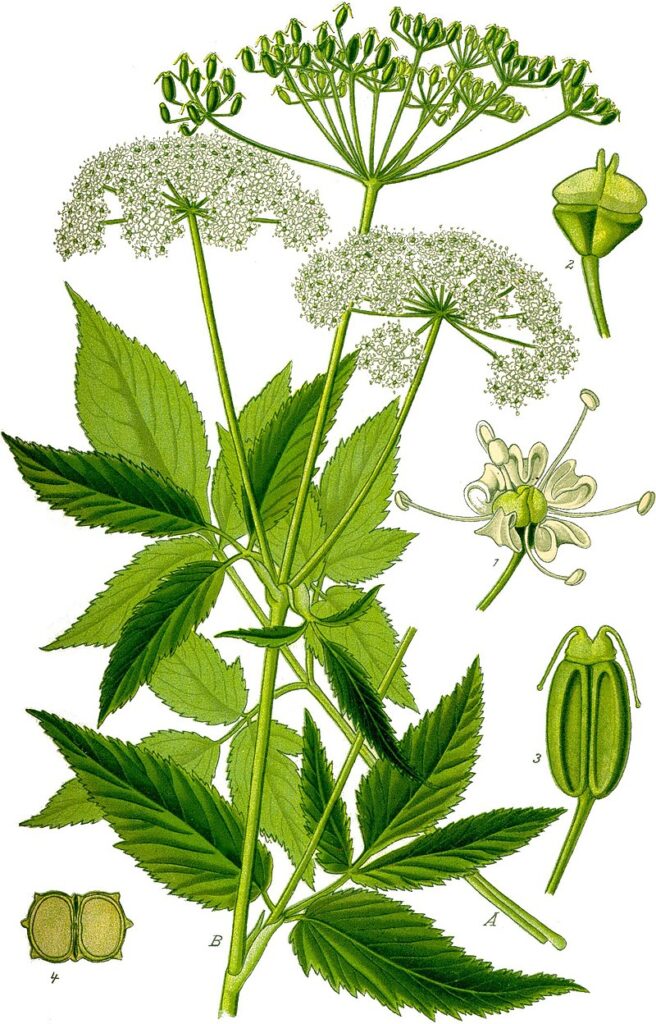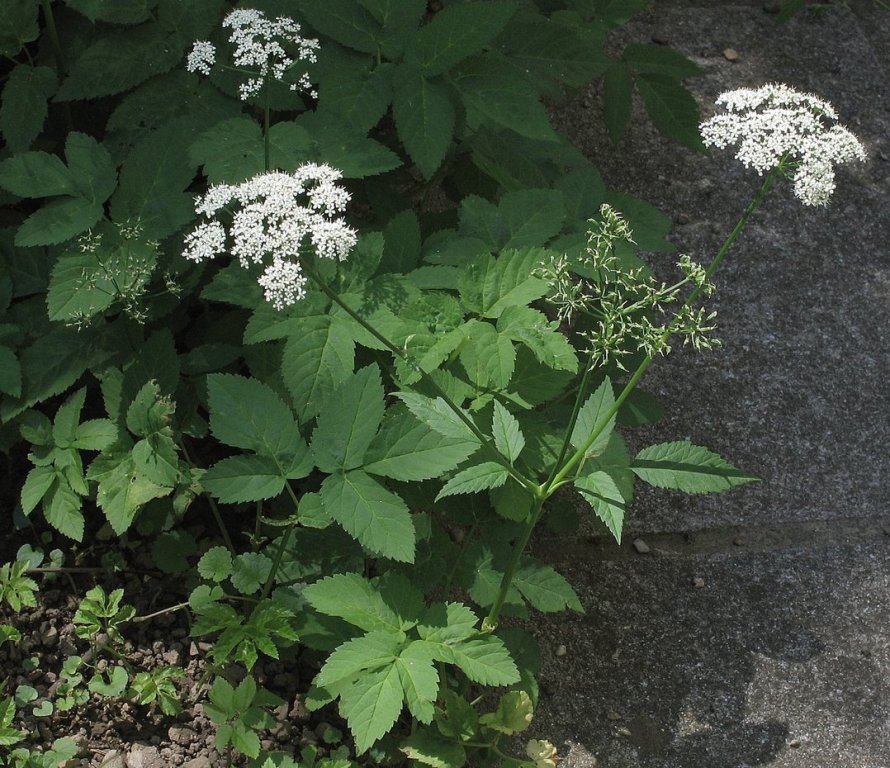
Ground-elder is mentioned by the RHS as a big menace in the garden and therefore an excellent reason for me to do this post!
See here for all other species of the Apiaceae in part 2. There is also a part 3, highlighting the medicinal uses more.
Contents
Aegopodium podagraria or Ground-elder
Wildlife and Other Uses
Edible Uses
Medicinal Uses

Aegopodium podagraria or Ground-elder
A rhizomatous perennial herb found in a wide variety of disturbed habitats, especially hedgerows, road verges, churchyards, gardens and waste ground. It typically occurs near human habitations or in the vicinity of abandoned settlements, often in shaded habitats. It reproduces by seed and by its aggressive rhizome system.
It is in the Apiaceae or Carrot family, which is number 138 in Stace.
The Apiacea is another large and frequent occurring family in the temperate world and it has many useful varieties with the occasional weedy one!
Stace has to say the following in the introduction of this family:
“Most of its species are unmistakable ‘umbellifers’, (Umbelliferae was its earlier family name) with compound umbels and characteristic fruits.
So fully ripe fruits are very useful for identification.
In Stace’s work 10 distinctive groups are first defined, followed by the keys…….”
In the Wild Flower Key ‘the Umbellifers’ as they are called here are keyed out into A & B and then B splits out into 7 further keys, grouping forms of leaves, flower colour and hairy or smooth stems/ leaves, etc.
Ground-elder can be found under the last group I: ‘Hairless umbellifers with leaves 2 or more times pinnate, unspotted stems, and white (or pinkish) flowers.’
The name “ground elder” comes from the superficial similarity of its leaves and flowers to those of elder (Sambucus), which is unrelated. It is the type species of the genus Aegopodium. This species is native to Eurasia, and has been introduced around the world as an ornamental plant, where it occasionally poses an ecological threat as an invasive exotic plant.
The plant is said to have been introduced into Great Britain by the Romans as a food plant and into Northern Europe as a medicinal herb by monks. It is still found growing in patches surrounding many monastic ruins in Europe, and descriptions of its use are found among monastic writings, such as in Physica by Hildegard von Bingen.
In my own experience working in private gardens is that this plant can be very difficult to get rid of, in amongst other herbaceous perennials in particular, Although it is fairly on the surface growing and rhizomes are easy to distinguish. It likes growing in good fertile soil and you just need to be persistent in getting it out each time you cultivate the soil!
Now over to the more positive things!
Wildlife and Other Uses:
In Eurasia, it is used as a food plant by the larvae of some species of Lepidoptera, including dot moth, grey dagger and grey pug, although A. podagraria is not the exclusive host to any of these species.
The flowers are visited by many types of insects, thus being characterised by a generalised pollination system.
The variegated form has been grown as an ornamental and is a good ground cover, as you reader can imagine!
Edible Uses:
- The tender leaves have been used in antiquity and throughout the Middle Ages as a spring leaf vegetable, much as spinach was used.
- Young leaves are preferred as a pot herb. It is best picked from when it appears (as early as February in the UK) to just before it flowers (May to June). If it is picked after this point, it takes on a pungent taste and has a laxative effect. However, it can be stopped from flowering by pinching out the flowers, ensuring the plant remains edible if used more sparingly as a pot herb.
Medicinal Uses:
- It also had a history as a medicinal herb to treat gout and arthritis, applied in hot wraps externally upon boiling both leaves and roots together.
- Ingested, the leaves have a diuretic effect and act as a mild sedative. Its use as a medicinal herb has largely declined during the modern era.
The Medicinal Flora by J.Barker has a big chapter on the Apiaceae and I have written about the other members in the family in previous mentioned posts. Here is what he has to say about the Ground-elder, which is also called Goutweed or Bishop’s Weed although I’d never heard of those names before:
“One would think that the medicinal use of a plant called Goutweed would speak for itself. There are many instances where a venerable tradition embodied in a name conveys valuable information-but this is not necessarily one of them. It was originally used as a potherb and gained its eponymous reputation from monasteries in the late middle ages: St Gerard is the patron saint of gout-sufferers. The name Bishop’s Weed was originally applied to the medicinal Ammi majus, then transferred to this plant. It is certainly diuretic but whether it reduces blood uric acid levels remains to validated.
- The root and leaf may be used in salad in spring for health benefit or
- the leaf taken as a tisane. [a ptysan originally meant a medicinal tea but now includes any pleasant and healthy beverage].
- As well as being taken internally they may be mashed together as a poultice and applied to painful hips and knees.
